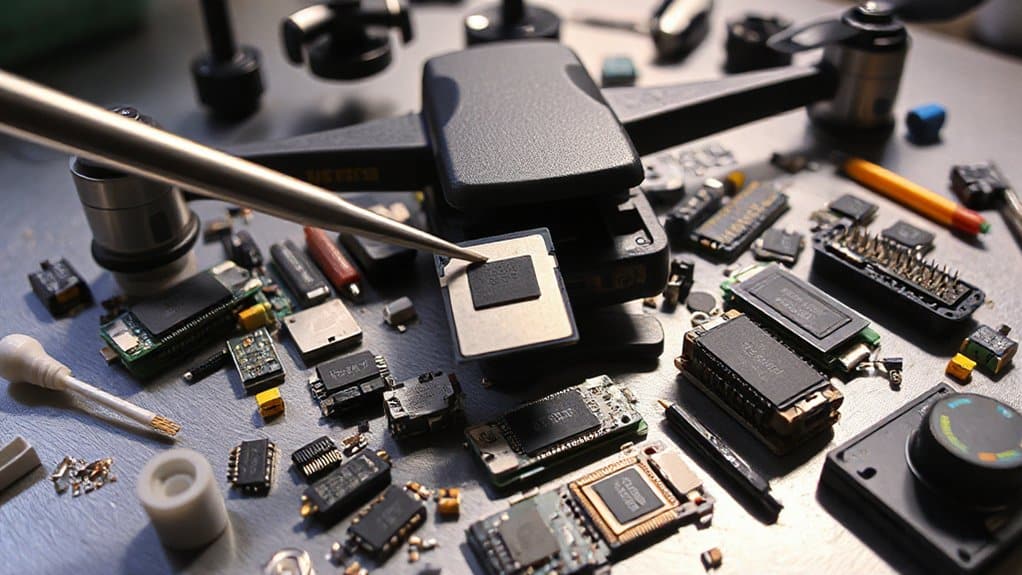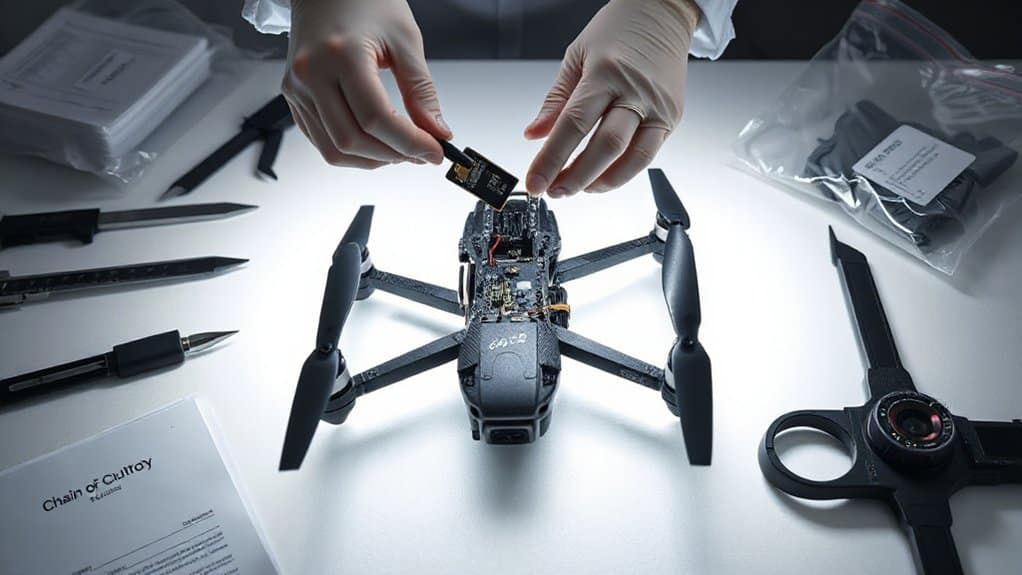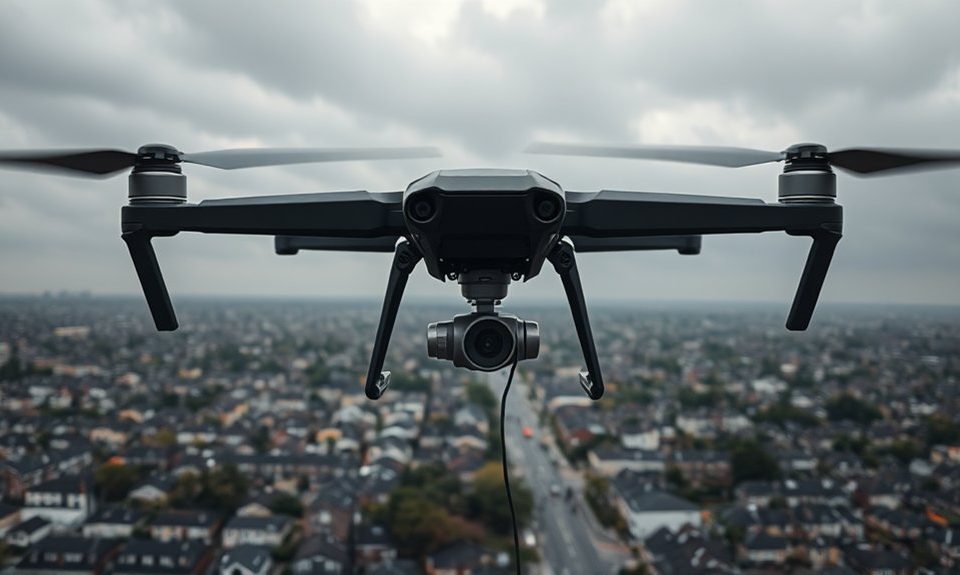Drone forensics involves systematic extraction and analysis of digital evidence from unmanned aerial systems’ storage components, including flight controllers, SD cards, and remote controllers. Investigators utilize specialized software and write-blocking techniques to preserve data integrity while recovering flight logs, telemetry records, GPS coordinates, and aerial imagery. Professional analysis reconstructs three-dimensional flight paths, examines operational parameters, and maintains strict chain-of-custody protocols for legal admissibility. These methodologies prove essential for regulatory compliance investigations and criminal prosecutions involving aerial surveillance, smuggling operations, and restricted airspace violations.
Key Takeaways
- Drone forensics involves extracting data from flight controllers, SD cards, remote controllers, and cloud services to preserve digital evidence integrity.
- Specialized tools perform memory dumps, use write-blocking techniques, and decrypt protected files while maintaining strict chain-of-custody documentation.
- Flight path reconstruction analyzes telemetry data, GPS coordinates, and sensor readings to create three-dimensional visualizations of drone movements.
- Legal admissibility requires cryptographically sealed evidence containers and rigorous adherence to jurisdictional protocols throughout the investigative process.
- Commercial investigations focus on regulatory compliance while criminal cases examine intent, payload modifications, and correlating digital evidence with physical crimes.
Understanding Drone Data Architecture and Storage Systems

How do investigators extract meaningful evidence from the complex digital ecosystem embedded within modern unmanned aerial vehicles? The forensic examination begins with understanding drone data architecture across multiple storage components. Flight control units maintain navigation logs, sensor readings, and operational parameters in dedicated memory modules. SD cards and internal flash storage house aerial imagery, video files, and metadata containing timestamps, GPS coordinates, and camera settings. Remote controllers store pairing information, flight paths, and user interactions within their encrypted databases. Cloud synchronization services create additional evidence trails through automated uploads. Investigators must systematically map these interconnected storage systems, identifying primary and backup data repositories. Each component requires specialized extraction techniques to preserve data integrity. Advanced Data Recovery Tools are essential in the retrieval of lost or deleted files, ensuring no critical evidence remains hidden within the drone’s digital infrastructure. Understanding manufacturer-specific architectures enables forensic professionals to develop thorough recovery strategies, ensuring no critical evidence remains hidden within the drone’s digital infrastructure.
Essential Tools and Techniques for Aerial Evidence Recovery
Specialized forensic tools enable investigators to systematically extract and analyze digital evidence from drone platforms without compromising data integrity. Professional-grade software suites facilitate thorough memory dumps from flight controllers, cameras, and storage modules using write-blocking techniques. Hardware interfaces connect directly to circuit boards, bypassing damaged ports or encrypted pathways. Image analysis techniques reconstruct flight paths through metadata examination, timestamp correlation, and geolocation verification. Data decryption methods access password-protected files and decode proprietary formats specific to manufacturer protocols. Chain-of-custody documentation guarantees evidence admissibility while specialized imaging tools create bit-for-bit copies of storage devices. Advanced hex editors reveal hidden partitions containing deleted footage, telemetry logs, and communication records essential for building extensive investigative timelines. Maintaining a secure chain of custody is crucial to ensure that evidence remains untampered and legally admissible.
Flight Path Reconstruction and Telemetry Analysis
Once investigators successfully extract raw data from drone systems, telemetry records provide detailed documentation of aircraft behavior throughout entire operational periods. Flight data analysis reveals precise coordinates, altitude variations, speed changes, and temporal sequences that establish definitive movement patterns. Forensic specialists utilize specialized software to reconstruct three-dimensional flight corridors, enabling visualization of complete operational timelines. GPS timestamps correlate with accelerometer readings, creating extensive behavioral profiles that withstand judicial scrutiny. Aerial mapping techniques overlay flight paths onto geographic datasets, revealing proximity to restricted zones, critical infrastructure, or incident locations. Professional investigators recognize that telemetry reconstruction serves as cornerstone evidence, transforming abstract data points into compelling visual narratives. This methodical approach guarantees forensic teams deliver irrefutable documentation that satisfies legal requirements while supporting investigative objectives. Moreover, understanding the risks of not hiring a professional can significantly enhance the credibility and accuracy of the findings.
Legal Frameworks and Chain of Custody Protocols

While drone forensics generates compelling technical evidence, legal admissibility depends entirely upon rigorous adherence to established chain of custody protocols and jurisdictional frameworks. Investigators must document every evidence handling step, from initial seizure through laboratory analysis, creating an unbroken chronological record. Legal considerations vary considerably across jurisdictions, particularly regarding privacy rights and warrant requirements for drone data acquisition. Digital evidence containers require cryptographic sealing to prevent evidence tampering accusations. Courts demand proof that data integrity remained intact throughout the investigative process. Forensic teams implement multi-signature verification systems, photographically document hardware conditions, and maintain detailed custody logs. Professional certification requirements guarantee investigators possess recognized qualifications for handling complex aeronautical evidence systems within judicial proceedings. Furthermore, adherence to legal standards is vital to ensure that drone-derived evidence is handled in compliance with the law.
Case Studies in Commercial and Criminal Drone Investigations
Although drone forensic methodologies remain consistent across investigation types, real-world applications reveal distinct analytical challenges between commercial compliance violations and criminal prosecutions. Commercial investigations typically focus on regulatory breaches—unauthorized flight zones, payload limitations, or operator certification failures. Forensic analysts examine flight logs, GPS coordinates, and operational parameters to establish compliance violations. Criminal cases demand deeper scrutiny of intent and premeditation. Recent smuggling investigations required extensive drone incident analysis of modified payload systems and encrypted communication protocols. Privacy invasion cases necessitate careful examination of aerial surveillance ethics, balancing investigative needs with constitutional protections. Successful prosecutions depend on correlating digital evidence with physical crime scenes, establishing operator identity through biometric data recovery, and demonstrating deliberate criminal intent through thorough behavioral pattern analysis. Additionally, utilizing forensically sound methods allows for the preservation of critical data which can be vital in both types of investigations.
Frequently Asked Questions
How Long Can Drone Flight Data Be Stored Before It Becomes Corrupted?
Data retention periods for drone flight information vary considerably based on storage conditions and technology employed. Storage durability depends on environmental factors, with solid-state drives typically maintaining integrity for 5-10 years under ideal conditions. The corruption timeline accelerates in adverse environments, potentially degrading within months. Professional investigators recognize that data recovery becomes increasingly challenging after two years, though specialized forensic techniques can sometimes extract valuable information from seemingly compromised storage media.
What Happens When Drone Evidence Conflicts With Eyewitness Testimony in Court?
When conflicting narratives emerge between drone evidence and eyewitness accounts, forensic investigators systematically evaluate testimony reliability against objective digital data. Courts typically prioritize verifiable metadata, flight logs, and sensor recordings over human recollections, which research demonstrates are susceptible to memory distortion and perception errors. Legal professionals within the forensic community recognize that technical evidence provides measurable parameters, timestamps, and GPS coordinates that establish factual baselines for resolving discrepancies in criminal proceedings.
Can Weather Conditions Affect the Accuracy of Recovered Drone Flight Data?
Weather impact greatly affects data reliability in recovered flight information. Temperature extremes can corrupt storage components, while moisture infiltration damages circuit boards and memory modules. High winds create sensor discrepancies between recorded versus actual flight paths. Lightning strikes cause electromagnetic interference, potentially altering logged coordinates. Forensic analysts must correlate meteorological records with recovery conditions to validate data integrity and establish accurate timelines for investigative purposes.
How Do Investigators Handle Encrypted or Password-Protected Drone Storage Systems?
Investigators employ specialized forensic recovery tools to bypass encrypted access controls on drone storage systems. Teams utilize hardware-based extraction methods, including chip-off techniques and JTAG protocols, to retrieve raw data before decryption barriers activate. Professional forensic suites contain algorithms designed specifically for common drone encryption schemes. When password protection remains intact, investigators apply dictionary attacks, brute-force methods, and manufacturer backdoors to gain system access systematically.
What Training Certifications Are Required to Become a Qualified Drone Forensics Expert?
Professional drone forensics experts must complete specialized drone certification programs covering UAV hardware architecture, communication protocols, and flight data interpretation. Essential forensic training courses include digital evidence preservation, data extraction methodologies, and legal chain-of-custody procedures. Industry-recognized certifications from aviation authorities and forensic organizations establish credibility within the investigative community. Practitioners typically pursue continuous education through advanced workshops addressing emerging drone technologies, encryption bypass techniques, and courtroom testimony protocols for maintaining professional competency standards.
Conclusion
Drone forensics represents a critical intersection of aviation technology and digital investigation methodologies. Successful aerial data analysis requires thorough understanding of storage architectures, specialized recovery tools, and precise flight reconstruction techniques. Legal compliance through proper chain of custody protocols guarantees evidence admissibility in judicial proceedings. The documented case studies demonstrate that systematic approaches to drone forensics yield actionable intelligence across commercial and criminal investigations, establishing this discipline as an essential component of modern digital forensic practice.






